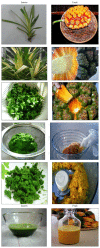Pandanus odoratissimus (Kewda): A Review on Ethnopharmacology, Phytochemistry, and Nutritional Aspects
- PMID: 25949238
- PMCID: PMC4408760
- DOI: 10.1155/2014/120895
Pandanus odoratissimus (Kewda): A Review on Ethnopharmacology, Phytochemistry, and Nutritional Aspects
Abstract
Pandanus odoratissimus Linn. (family: Pandanaceae) is traditionally recommended by the Indian Ayurvedic medicines for treatment of headache, rheumatism, spasm, cold/flu, epilepsy, wounds, boils, scabies, leucoderma, ulcers, colic, hepatitis, smallpox, leprosy, syphilis, and cancer and as a cardiotonic, antioxidant, dysuric, and aphrodisiac. It contains phytochemicals, namely, lignans and isoflavones, coumestrol, alkaloids, steroids, carbohydrates, phenolic compounds, glycosides, proteins, amino acids as well as vitamins and nutrients, and so forth. It is having immense importance in nutrition. A 100 g edible Pandanus pericarp is mainly comprised of water and carbohydrates (80 and 17 g, resp.) and protein (1.3 mg), fat (0.7 mg), and fiber (3.5 g). Pandanus fruits paste provides 321 kilocalories, protein (2.2 g), calcium (134 mg), phosphorus (108 mg), iron (5.7 mg), thiamin (0.04 mg), vitamin C (5 mg), and beta-carotene (19 to 19,000 μg) (a carotenoid that is a precursor to vitamin A). Pandanus fruit is an important source of vitamins C, B1, B2, B3, and so forth, usually prepared as a Pandanus floured drink. Traditional claims were scientifically evaluated by the various authors and the phytochemical profile of plant parts was well established. The methods for analytical estimations were developed. However, there is paucity of systematic compilation of scientifically important information about this plant. In the present review we have systematically reviewed and compiled information of pharmacognostic, ethnopharmacology, phytochemistry, pharmacology, nutritional aspects, and analytical methods. This review will enrich knowledge leading the way into the discovery of new therapeutic agents with improved and intriguing pharmacological properties.
Figures
References
-
- Kirtikar K. R., Basu B. D., Blatter E. Indian Medicinal Plants. Vol. 4. New Delhi, India: Indian Book Center; 1991.
-
- Charterjee A., Pakrashi S. C. The Treatise of Indian Medicinal Plants. 2nd. Vol. 6. New Delhi, India: National Institute of Science Communication; 2001.
-
- Anonymous. The Wealth of India: Raw Materials. Vol. 7. New Delhi, India: Publications and Information Directorate, Council for Scientific and Industrial Research; 1966.
-
- Prajapati N. D., Purohit S. S., Sharmak A., Kumar T. A Handbook of Medicinal Plants. 1st. Jodhpur, India: Agrobios; 2003.
-
- Wen C.-S., Hsiao J.-Y. Genetic differentiation of Lilium longiflorum Thunb. var. Scabrum Masam. (Liliaceae) in Taiwan using random amplified polymorphic DNA and morphological characters. Botanical Bulletin of Academia Sinica. 1999;40(1):65–71.
Publication types
LinkOut - more resources
Full Text Sources
Other Literature Sources
Research Materials



